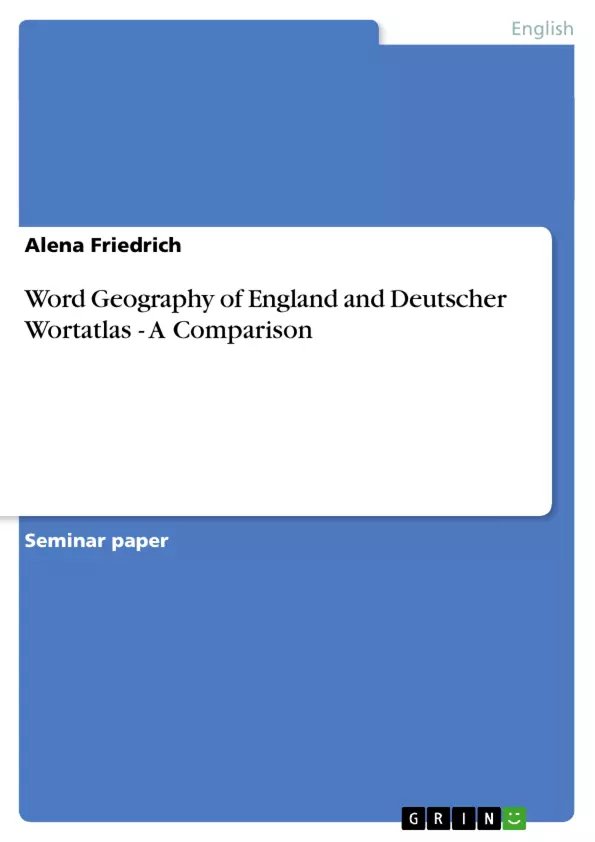“Harold Orton often told us that it was the eleventh hour, that dialect was rapidly disappearing, and that this [the Survey of English Dialects] was a last-minute exercise to scoop out the last remaining vestige of dialect before it died out under the pressure of modern movement and communication”.
(Stanley Ellis, In: Rawling, p.1)
As Stanley Ellis, one of Harold Orton's colleagues in the Survey of English Dialects, points out in this quote, English linguists became aware in the 1950s that it was high time for a long-term dialect survey in their home country. Orton, the initiator of the Survey of English Dialects, knew that the modern means of communication, the increasing urbanisation and the decreasing number of those informants who were still untouched by modernisation, would soon make it impossible to collect authentic data of English dialects. So they started work as soon as possible. Later, a number of English dialect atlases were brought out on the basis of the SED; among them the lexicon-based Word Geography of England by Harold Orton and Nathalia Wright.
When the German linguist Georg Wenker carried out his first dialect surveys in Germany in the 1890s, the problem of modernisation was not as significant as it was 60 years later. Wenker's motivation rather was to find clear dialect boundaries in Germany and later in the entire German speaking area. With his far-reaching survey, the Deutscher Sprachatlas, Wenker laid the foundation of German dialectology, causing many linguists to adopt his example in the following years. One of these linguists was Walther Mitzka who published the first lexical dialect atlas for the German speaking area, namely the Deutscher Wortatlas.
The aim of the following essay will be to compare the WGE and the DWA. The comparison will be carried out, firstly, with regard to the methodology of the surveys which provided the data for the atlases, and, secondly, with regard to the actual publications, i.e. the WGE and the DWA themselves. In order to make the comparison comprehensible for the reader I have added some material from the atlases to the appendix. Furthermore, a table which lists the differences between the DWA and the WGE in short form, is added.
Finally, the appendix includes a newspaper article which describes the data collection of the SED in York.
Inhaltsverzeichnis (Table of Contents)
- 1. INTRODUCTION
- 2. AN INTRODUCTION TO THE SURVEY OF ENGLISH DIALECTS (SED) AND THE DEUTSCHER SPRACHATLAS (DSA)
- 3. THE METHODOLOGY OF THE SURVEY OF ENGLISH DIALECTS (SED) AND THE DEUTSCHER WORTATLAS (DWA)
- 3.1 THE METHOD OF DATA COLLECTION
- 3.2. THE SAMPLING
- 3.3. THE QUESTIONNAIRES
- 3.4. THE ACTUAL DATA COLLECTION
- 4. THE PUBLICATION OF THE FINDINGS
- 4.1. HOW ARE THE ATLASES ORGANIZED?
- 4.2. WHICH FORMAT OF PRESENTATION WAS CHOSEN?
- 4.3. WHICH ITEMS WERE MAPPED?
- 4.4. HOW ARE THE LOCALITIES PRESENTED?
- 4.5. HOW ARE THE COLLECTED ITEMS PRESENTED?
- 5. CONCLUDING REMARKS – ADVANTAGES AND DISADVANTAGES OF THE WORD GEOGRAPHY OF ENGLAND AND THE DEUTSCHER WORTATLAS
- 6. REFERENCES
Zielsetzung und Themenschwerpunkte (Objectives and Key Themes)
This essay aims to compare the Word Geography of England (WGE) and the Deutscher Wortatlas (DWA), focusing on the methodology of the surveys which provided the data for the atlases, and the actual publications themselves. The comparison includes material from the atlases and a table outlining key differences.
- The historical context and motivation for conducting the surveys.
- The methodology employed in collecting dialect data.
- The publication format and presentation of findings in the atlases.
- A comparative analysis of the advantages and disadvantages of each atlas.
- The significance of the WGE and the DWA in the fields of English and German dialectology.
Zusammenfassung der Kapitel (Chapter Summaries)
The introduction discusses the urgency of the Survey of English Dialects (SED) in the 1950s, highlighting the pressure of modernization and urbanization on English dialects. It also introduces Georg Wenker's German dialect surveys in the 1890s and the motivation for his work. Chapter 2 provides an overview of the SED and the Deutscher Sprachatlas (DSA), focusing on their origins and objectives.
Schlüsselwörter (Keywords)
Key terms and concepts include dialect geography, English dialects, German dialects, Survey of English Dialects (SED), Deutscher Sprachatlas (DSA), Word Geography of England (WGE), Deutscher Wortatlas (DWA), methodology, data collection, publication format, lexical atlases, comparative analysis.
- Quote paper
- Alena Friedrich (Author), 2001, Word Geography of England and Deutscher Wortatlas - A Comparison, Munich, GRIN Verlag, https://www.grin.com/document/14483



